Blog in Polish/blog w języku polskim: http://ontario-nature-polish.blogspot.com/2020/08/hotel-carisol-los-corales-and-santiago.html
More photos from this trip: https://www.flickr.com/photos/jack_1962/albums/72157715783102422
It
was our 15th trip to Cuba since 2009 and third to the Hotel Carisol
los Corales, so we knew what to expect. We paid $1,295 CAN per person for 2
weeks (from Toronto) for a junior suite in the Carisol Section.
 |
| Junior Suite C-3 |
Before our January 8, 2020 departure (from Toronto to Santiago de Cuba), we had booked our Sunwing seats online 24 hours in advance and got the boarding pass. We thought it was a great idea—until we got to the airport (Pearson’s Terminal 3). We had to deal with the kiosks to print luggage tags and figure out how to put them on our luggage, which was not as easy as it looked, there were plenty of confused tourist and two employees were quite busy helping them. Then there were problems with placing our suitcases on the conveyor belt, somehow they were not ‘recognized’ by the scanner. We had to carry our baggage and line up to another conveyor belt and airport employees had to help us a lot. Overall, we spent more time than in the past checking in the luggage.
 |
| Club Amigo Carisol |
We were told to go gate B26 and get on the bus. On the BUS? I thought she meant the PLANE? Actually, we did get on the bus and after a 10 minute ride, we ended up at the Infield Terminal, which I had no idea existed! Later I found out that this overflow terminal was rarely used, but in December, 2019 Sunwing Airlines moved their operations there. It is also frequently used as a location for major motion pictures and TV productions.
 |
| We also enjoyed the company of various animals, grazing just in front of our room |
 |
| The Sunwing plane |
Because of TripAdvisor’s Cuban forums, I knew that unexpectedly the US dollar had become a hot commodity in Cuba—and we happened to have plenty of US dollars anyway. Within minutes of getting on the bus we exchanged $200 US and got 200 CUC—more than enough for our whole stay. I also ran to the nearby kiosk and got 2 cans of Cuban beer (Cristal). It turned out that I bought the last 2 cans—and that was the only Cuban beer (in cans or bottles) I had during my whole trip. Some tourists also discovered that their luggage was not on the plane and it was supposed to be delivered the next day(s). It took us over 1 hour to get to the hotel. Our very nice and personable rep on the bus, Sahidy, told us a lot of interesting things on Cuba.
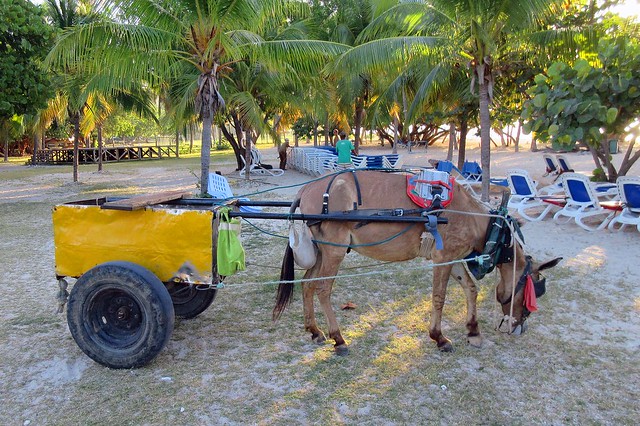 |
| On the beach |
HOTEL
We got the Junior Suite C-3 (upper level). We were not very thrilled with the room (or rather the location of the building), but decided to stay—we liked better the Junior Suite H-4, where we had stayed previously. We had the same maid as 2 years ago, Martha.
The staff was overall nice and helpful, although I saw a lot of new, young people working at the reception and most of them barely spoke English—and I had a feeling they were not too eager to practice their meager linguistic skills with tourists.
 |
| Inside our Junior Suite C-3 |
 |
| Sunset at the beach |
There was no Canadian channel on TV, only the CNN, which I never liked watching. We tried to watch the 6 pm news, but sometimes such ‘momentous’ news like the story about the royal couples announcing their intention to step back as senior members of the royal family took up the first 20 minutes, relegating other ‘inconsequential’ news items as the Ukrainian plane disaster, Iranian Crisis or the coronavirus outbreak in the background! That was why we spent just minutes watching TV.
 |
| Ruins of the old hotel buildings, destroyed years ago by a hurricane |
From our balcony we could see the ocean and, mostly covered by vegetation, the ruins of old hotel buildings (disco), destroyed years ago by a hurricane. There were always various animals grazing the grass around, mostly horses and donkeys (with cattle egrets hanging around them), which gave this place a very rustic look. Cats and dogs were not as numerous as in the past.
The beach was nice and the beach guys quickly brought us loungers. The coco bar served cold beer and other drinks—Frank the bartender did a great job and I especially loved the piña colada. There was a massage place on the beach and Catherine had a massage every day. I hoped to do snorkeling, but every day was quite windy and there were relatively high waves near the reef, making snorkeling there too risky. But closer to the shore I did see a lot of colorful fish and even a moray eel, luring from an opening in a rock.
I brought a relatively new book by John Grisham, “The Reckoning”. It was certainly NOT a typical legal thriller that one would expect from this author. The story was set in Mississippi, in the 1940s, and in addition to some courtroom drama, it contained a lot of other elements, such as family matters & secrets, life on a cotton plantation and race relations. And from the flashbacks to the Second World War I learned a lot about the Japanese invasion of the Philippines, the surrender of the U.S. forces and the Bataan Death March.
We had the best January weather ever in Cuba: every day was sunny, about +30 C and it rained a few times, but by the time we reached our room, the sky was blue again. Because of the wind there were no mosquitos or other bugs.
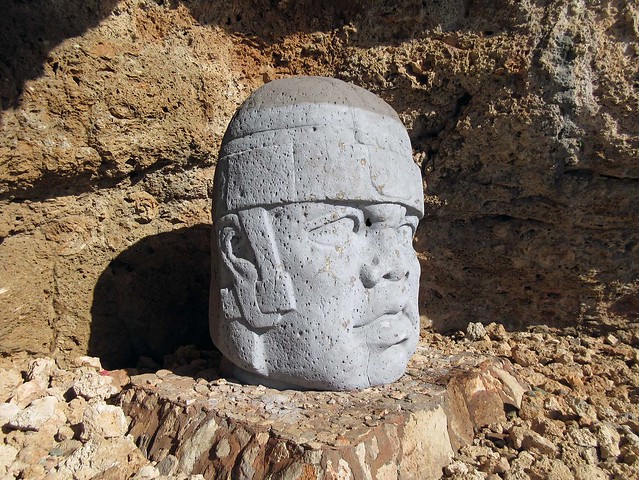 |
| Exposición Mesoamericana close to the hotel. Apparently it is genuine fake pre-columbian art! |
The Carisol section (where we stayed) was much quieter than the los Corales section, where all the entertainment took place—and it was one of the main reasons we decided to stay in the Carisol part of the resort.
On the bus to the resort we ran into a couple from Streetsville that we had met at the hotel two years ago and during our stay we frequently enjoyed dinners together. We also (finally!) met in person two well-known TA members, Cubacarol and CoralQueen, whose posts I had read for many years and often relied on their valuable advice. In fact, it was CoralQueen who had recommended our casa particular in Santiago de Cuba in 2010! We met Karen from Quebec, with whom we had gone biking two years ago to the Jardin de Cactus and whose excellent Spanish greatly enhanced our outing! Besides, we often intermingled with other tourist from Canada and exchanged a lot of interesting stories on travelling in Cuba and in other countries.
FOOD/DINING
The food was average, but tasty and I had no complains. For breakfast I always had fried eggs, coffee and yogurts. Most of the time we skipped lunch, but a few times we went to the Ranchon Restaurant for excellent ribs and fish. Dinners offered a lot of various dishes. I loved grilled pork at the cooking station, it was delicious—unfortunately, twice I tried beef and it was tough & stringy—well, at least the local dogs enjoyed it… We brought several salad dressings which greatly enhanced the taste of salads. Yet after a week I did experience some mild stomach problems—there was nothing wrong with the food, but I guess the greens did not agree with my gut flora. Although we never noticed any beer or wine shortages in the resort, the wine was ‘rationed’—the servers poured only half a glass of wine and never left a bottle of wine on the table.
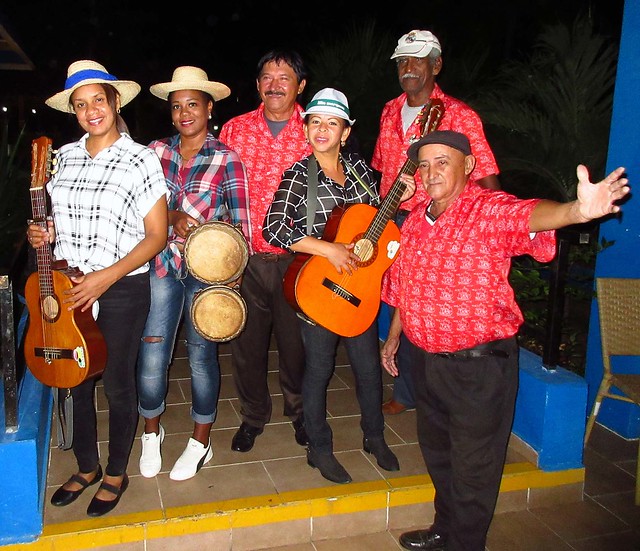 |
| The (very noisy!) Cuban band |
Every evening a Cuban band would provide musical entertainment while we were dining. I had really mixed feelings about them: on one hand it was nice to listen to one or two songs and admire their artistic talents, but after a while they kind of overstayed their welcome, making it literally impossible for us to conduct any meaningful conversation at the table. The performers were standing very close to our tables and were very deafening! Even if Frank Sinatra were singing like that, I’d say, “Get lost, Frankie, and pop up somewhere else!” We were often relieved when they finally went elsewhere in search of other victims... I mean, tourists!
 |
| During our stay a painter created this mural |
HOTEL STORES (TIENDAS)
For the first time in 11 years it was impossible to buy any Cuban beer in the hotel stores! What’s more, on the second day after our arrival I purchased one bottle of mineral water and 2 bottles of Cuban liquors—it turned out that from then on there were no liquors and no mineral water available at the store! I brought tabasco sauce, hoping to make a Bloody Mary—but there was no vodka and no tomato juice in the store either. Well, I’m glad that there was draft beer at the bars. By the way, during our two trips to Santiago de Cuba, it was impossible to obtain Cuban beer and I only managed to get Heineken. At Plaza Dolores two restaurants had no beer and the third one eventually got some. I could not even find mineral water and I got very thirsty.
 |
| Catherine with a broken bike. As you can see, despite any predicaments, she is always smiling! After all, 'es Cuba'... |
RENTAL BIKES AND WALKS AROUND THE HOTEL
We had been looking forward to renting bikes at the hotel and exploring nearby attractions. This year there were only 4 bikes available for rent. We rode to the blow holes (past the aquarium) and then Catherine’s bike got a flat tire—it was literally peeling off the wheel, so it was impossible to even walk the bike. She rode my bike to the hotel and sent a horse carriage to pick up me and the broken bike.
 |
| The blow holes several kilometers from the hotel |
We got another one and the next day in the morning rode to the village of Baconao—just in time to see the start of the elementary school at 8:00 in the morning, where students were reciting some revolutionary stanzas and singing. Later we toured the small school and spoke to the teachers, giving them several bilingual periodicals.
Since we were supposed to return the bikes at 10 am, I was already at the rental place at 9:45 am, but it was still closed. I waited for over one hour (in the meantime, two people wanted to rent scooters and another tourist was impatiently waiting to return one), but the rental place remained closed, its sole employee nowhere to be seen. Just before 11 am I dragged the bikes to the reception and in spite of the protestations of the reception clerk, I placed them in the storage room. I suspect that the hotel is going to be very pleased when the remaining bikes finally break down—one less issue to deal with!
 |
| School in Baconao village |
In the morning we walked around the hotel and twice explored the nearby caves along the coastal cliffs with indigenous cave art from Central and South America (Exposición Mesoamericana). On a couple of occasions we spoke to the gardener working there—he showed us bats (“murciélagos”) attached to the caves’ walls. We also noticed that the restaurants that we had seen two years ago now were gone—a tourist told us that they were private and too successfully competed with nearby government establishments…
 |
| Start of the day in elementary school in Bacono village |
 |
| Monument of Francisco Vicente Aquilera |
There were many restaurants and the old church of Dolores, converted into a concert hall, as well as an impressive monument of Francisco Vicente Aguilera (1821-1877), a Cuban patriot, mayor of Bayamo, Vice President of the Republic and insurrectionist.
 |
| Calle Jose Antonio Saco, a.k.a. Enramada |
Just steps from the plaza was Calle Jose Antonio Saco, a.k.a. Enramada, closed off to traffic, always full of pedestrians, shops, restaurants and other businesses. We walked along this street several times, bought several delicious ‘churros’ (paying with CUP, or “Moneda national”) and also visited a number of casas particulares, some were quite nice and offered a great view of the city. There was even a shop offering “Las Mascotas”—yes, it was a pet shop!
 |
| An antique vehicle on Plaza Dolores, which I was not supposed to photograph, according to one funny Cuban fellow! |
There were plenty of Cubans at Plaza Dolores—indeed, some tried do beg and asked for money, but most of them did not bother tourist. Two years ago I had taken a video of an older Cuban gentleman who was playing the guitar and singing, which I later posted on YouTube.
 |
| With a guitar player |
Later, as I was taking photos of surrounding buildings, I spotted a beautiful antique car which I commenced to photograph. All of a sudden an agitated man showed up and, while hurriedly waving his arms, was shouting that I was not supposed to take photos of the car without paying (him?). Of course, I totally ignored him and continued my business. As quickly as he appeared, he was gone—and to make the story even more amusing, the car did not even belong to him!
 |
 |
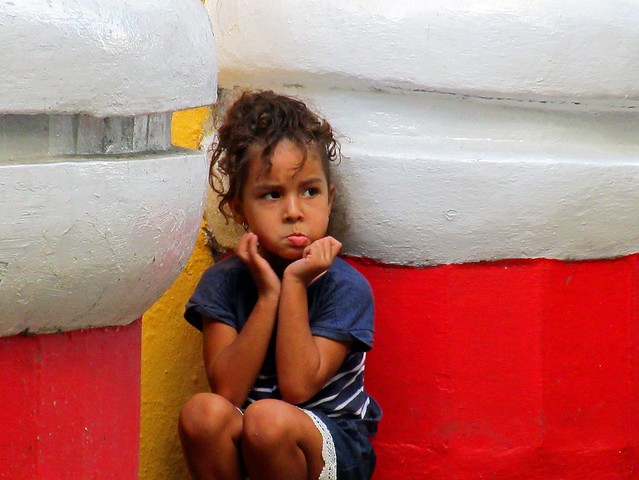 |
| This Cuban girl was so adorable! |
While waiting at Plaza Dolores for the hotel bus to pick us up, we sat at the outdoor patio of the Restaurante Don Antonio and ordered a couple of drinks as well as cold beer—it was the only establishment in the vicinity that had beer, the other ones had none. There was a Cuban family sitting nearby and I took a series of amazing photographs of their adorable daughter! The servers were quite nice and I am grateful that they managed to find beer—who would have ever guessed beer would become so difficult to find?
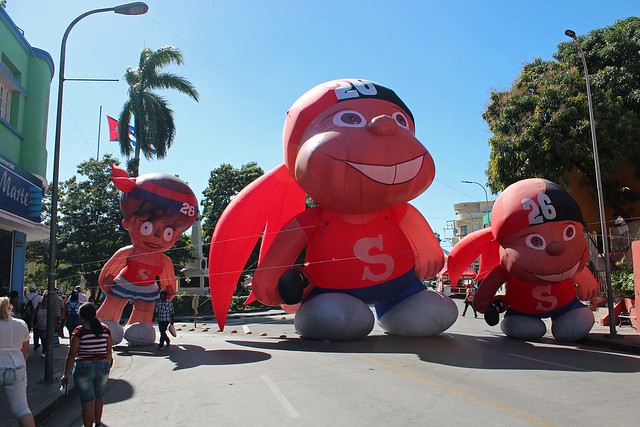 |
| Festivities at Plaza de Marte |
Twice we walked to Plaza de Marte, where some kind of festivities were taking place there, the surrounding streets were closed off to traffic and there were plenty of various booths/kiosks selling food. Of course, the plaza was teeming with Cubans, who were strolling, sitting and checking out the attractions. Unfortunately, it was impossible to purchase any Cuban beer anywhere nearby and only after searching several stores I managed to buy German-made beer “Heineken”, created to commemorate Havana’s 400th anniversary. Very close to the Plaza was a Communist Party of Cuba Provincial Head Office—since there were a lot of photographs hanging in the lobby (most likely related to the Cuban Revolution), I asked if it was possible to take a look at them, but the guards did not let me in. I wonder why?
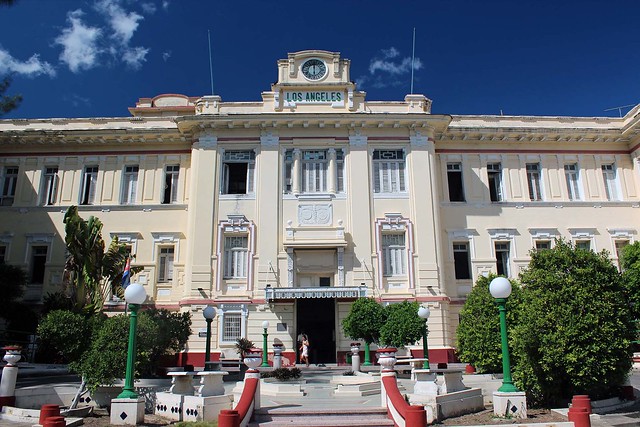 |
| Los Angeles Hospital |
On our way to the Moncada Barrack, we made a shortcut through the Los Angeles Hospital grounds. Built decades before the Revolution, it was quite impressive. On our way back we also wanted to cut through the hospital’s grounds, but that time a security guard said ‘no’ and was very adamant not to let us through. The only explanation is that between certain hours tourists are not allowed on the hospital grounds…
 |
| The Moncada Barracks, with bullet-pockmarked walls |
The highlight of the trip was the visit to the Moncada Barracks. In fact, we went there, albeit briefly, during our first bus tour to Santiago, but only during the second bus trip to Santiago we spent over one hour inside the building and saw the exhibits.
 |
| The Moncada Barracks, today an elementary school and a museum |
I had seen the building numerous times on TV, in books, magazines and propaganda materials. Indeed, it is called the cradle of the Cuban Revolution. It was here that on July 26, 1953, the 26-year old Fidel Castro, along with a band of 111 ill-armed men attacked the Moncada Barracks. It was a total failure—some 60 men were shot or tortured to death, the rest, including Fidel Castro and his brother Raul, fled. Later Fidel Castro was captured by Lieutenant Pedro Manuel Sarria Tartabull who, instead of executing him on the spot, as ordered, kept him alive. It was during his trial that the uttered the now famous words: “History will absolve me.” He was sentenced to 15 years, yet released after 2 years. Soon Fidel and Raul Castro left for Mexico, where they befriended an Argentinian doctor, Ernesto “Che” Guevara. On November 25, 1956 Castro (incidentally, he would die, to the day, 60 years later), along with 81 revolutionaries, left Mexico on a decrepit boat called “Granma” and landed in Cuba on December 2, 1956. The landing, like the Moncada Barracks attack, was another disaster—62 of the rebels were killed or captured. After a 2 year guerilla war, Batista fled into exile on December 31, 1958 and the next day Castro proclaimed the victory of the Cuban Revolution. That is why the number “26” has become a symbol of the revolution and can be seen everywhere in Cuba.
 |
| In front of the Moncada Barracks |
The building has this very distinctive mustard-and-white color. Part of the building is a museum, the other part a school. The museum exhibits plenty of photos, uniforms, maps, torture devices and photographs of Castro’s men who took part in the attack. At the entrance to the barracks there were a number of photographs depicting various dignitaries visiting the Moncada Barracks, often guided by Fidel Castro himself. I immediately recognized Henryk Jabłoński, head of state of the People's Republic of Poland between 1972 and 1985, who paid a visit in 1979. Unfortunately, all the descriptions in the museum were in Spanish, not in English, so I was not really able to comprehend and understand much. It is quite puzzling—after all, I believe that it would be in the interest of the Cuban government to inform tourists about its revolutionary history.
One of the most prominent features of the building’s façade are
the bullet holes, allegedly made by the rebels’ inadequate weapons. Recently I
found out that they were not real! According to an article by Stephen Hunter from
“The Washington Post” (2003), as well as according to Dr. Antonio de la Cova’s presentation
on his new book, “The Moncada Attack: Birth of the Cuban Revolution”, the
original bullet holes had been eradicated by the Batista regime after the
attack. It was only after the Revolution the holes were re-created by the new
government. Besides, Dr. de la Cova said that the holes had NOT been made by
the rebels, but by the soldiers.
 |
| The Moncada Barracks |
I would also like to mention the Siboney Farm, where the rebels had been preparing for the Moncada attack—and it was from this farm that they left for Santiago to carry on the attack on the Moncada Barracks. After the attack some of the rebels returned to the farm. The same day soldiers discovered the farm and eventually sprayed the façade of the house with a machine gun—the bullets holes are still visible. Since the Farm is just meters from the road between Santiago and our resort, we passed it many times.
 |
| No roof? No problem, the umbrellas will protect you from rain! I remember a Polish song by Maria Koterbska, appropriately called "Umbrellas, umbrellas"; its refrain goes like that: Umbrellas, umbrellas for adults and for children! Umbrellas, umbrellas – they won’t let through a single drop! Umbrellas, umbrellas, very cheap umbrellas! Umbrellas, umbrellas – please buy them, ladies and gentlemen! https://www.youtube.com/watch?v=yugEIsB2wV0 |
Blog in Polish/blog w języku polskim: http://ontario-nature-polish.blogspot.com/2020/08/hotel-carisol-los-corales-and-santiago.html
More photos from this trip/: https://www.flickr.com/photos/jack_1962/albums/72157715783102422
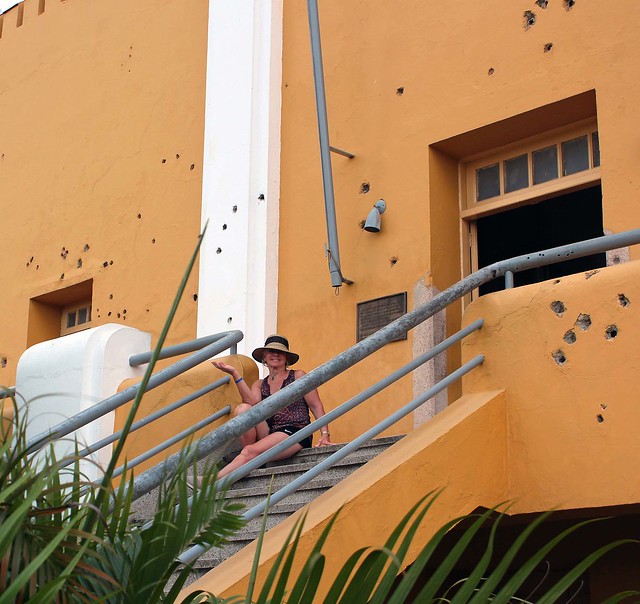


No comments:
Post a Comment